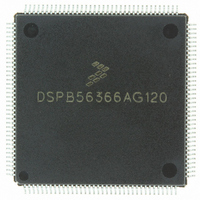DSPB56366AG120 Freescale Semiconductor, DSPB56366AG120 Datasheet - Page 18

DSPB56366AG120
Manufacturer Part Number
DSPB56366AG120
Description
IC DSP 24BIT AUD 120MHZ 144-LQFP
Manufacturer
Freescale Semiconductor
Series
Symphony™r
Type
Audio Processorr
Datasheet
1.DSPB56366AG120.pdf
(110 pages)
Specifications of DSPB56366AG120
Interface
Host Interface, I²C, SAI, SPI
Clock Rate
120MHz
Non-volatile Memory
ROM (240 kB)
On-chip Ram
69kB
Voltage - I/o
3.30V
Voltage - Core
3.30V
Operating Temperature
-40°C ~ 110°C
Mounting Type
Surface Mount
Package / Case
144-LQFP
Lead Free Status / RoHS Status
Lead free / RoHS Compliant
Available stocks
Company
Part Number
Manufacturer
Quantity
Price
Company:
Part Number:
DSPB56366AG120
Manufacturer:
TOSHIBA
Quantity:
639
Company:
Part Number:
DSPB56366AG120
Manufacturer:
FREESCAL
Quantity:
273
Company:
Part Number:
DSPB56366AG120
Manufacturer:
Freescale Semiconductor
Quantity:
10 000
2.9
2-14
Signal
Name
HCKR
HCKT
PC2
PC5
FSR
PC1
Enhanced Serial Audio Interface
Input, output, or
Input, output, or
Input, output, or
Input or output
Input or output
Input or output
disconnected
disconnected
disconnected
Signal Type
Table 2-11 Enhanced Serial Audio Interface Signals
disconnected
disconnected
disconnected
disconnected
disconnected
disconnected
State during
Reset
GPIO
GPIO
GPIO
GPIO
GPIO
GPIO
DSP56366 Technical Data, Rev. 3.1
High Frequency Clock for Receiver—When programmed as an input, this
signal provides a high frequency clock source for the ESAI receiver as an
alternate to the DSP core clock. When programmed as an output, this signal
can serve as a high-frequency sample clock (e.g., for external digital to analog
converters [DACs]) or as an additional system clock.
Port C 2—When the ESAI is configured as GPIO, this signal is individually
programmable as input, output, or internally disconnected.
The default state after reset is GPIO disconnected.
This input is 5 V tolerant.
High Frequency Clock for Transmitter—When programmed as an input,
this signal provides a high frequency clock source for the ESAI transmitter as
an alternate to the DSP core clock. When programmed as an output, this
signal can serve as a high frequency sample clock (e.g., for external DACs)
or as an additional system clock.
Port C 5—When the ESAI is configured as GPIO, this signal is individually
programmable as input, output, or internally disconnected.
The default state after reset is GPIO disconnected.
This input is 5 V tolerant.
Frame Sync for Receiver—This is the receiver frame sync input/output
signal. In the asynchronous mode (SYN=0), the FSR pin operates as the
frame sync input or output used by all the enabled receivers. In the
synchronous mode (SYN=1), it operates as either the serial flag 1 pin
(TEBE=0), or as the transmitter external buffer enable control (TEBE=1,
RFSD=1).
When this pin is configured as serial flag pin, its direction is determined by the
RFSD bit in the RCCR register. When configured as the output flag OF1, this
pin will reflect the value of the OF1 bit in the SAICR register, and the data in
the OF1 bit will show up at the pin synchronized to the frame sync in normal
mode or the slot in network mode. When configured as the input flag IF1, the
data value at the pin will be stored in the IF1 bit in the SAISR register,
synchronized by the frame sync in normal mode or the slot in network mode.
Port C 1—When the ESAI is configured as GPIO, this signal is individually
programmable as input, output, or internally disconnected.
The default state after reset is GPIO disconnected.
This input is 5 V tolerant.
Signal Description
Freescale Semiconductor











